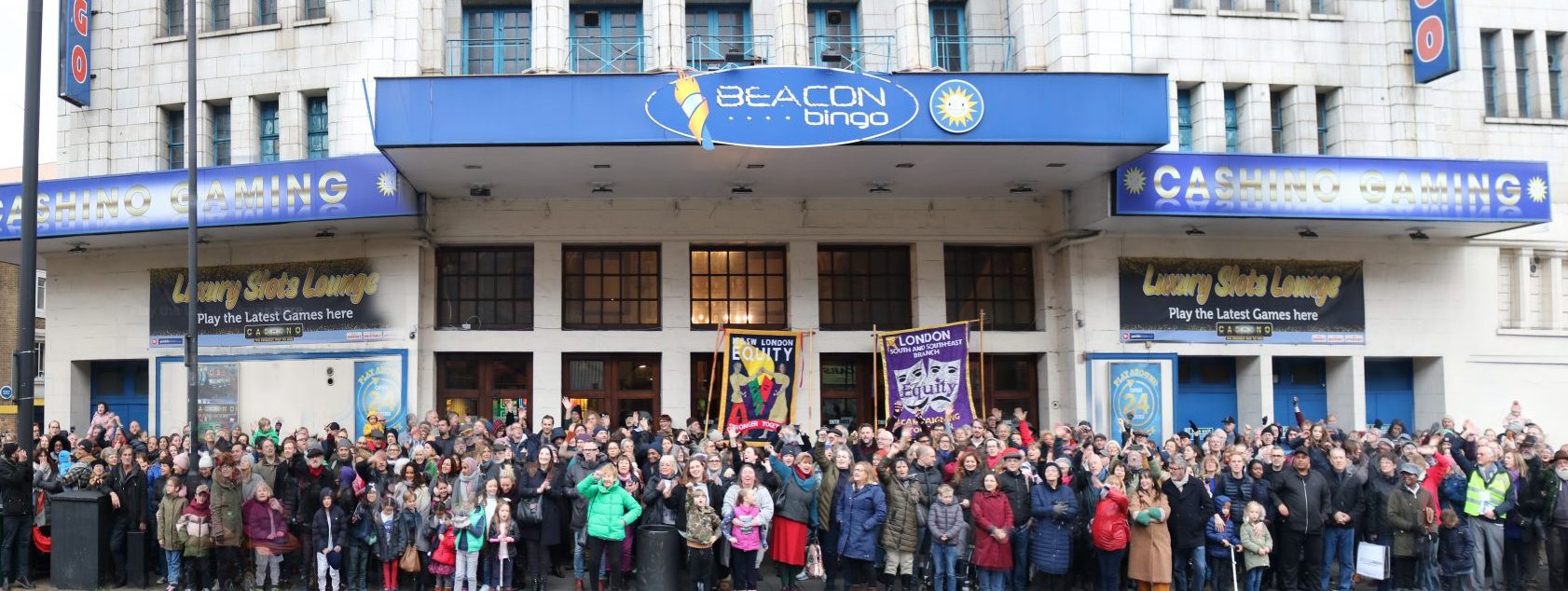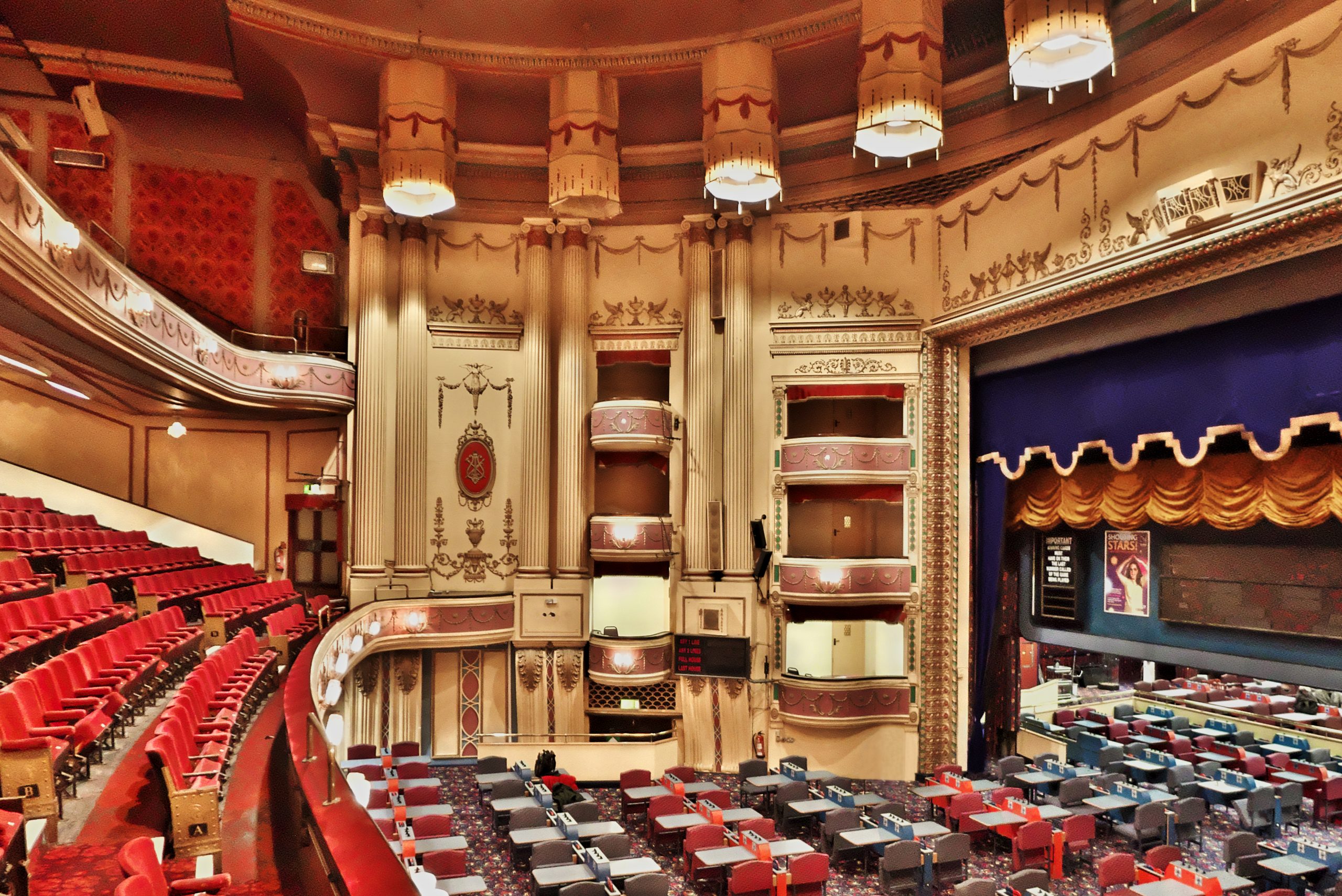Published: (Updated: )
Report says regenerating Streatham Hill Theatre can kickstart local high street revival
An independent study published today says that restoring the dormant historic building as a centre for arts and culture “could play a major role in leading the post-Covid high-street recovery, developing the 15-minute neighbourhood, increasing localised co-working opportunities and ultimately making a significant economic contribution to the regeneration of this part of London”.
The Viability Study and Economic Impact Assessment was carried out by a team led by renowned arts consultancy, FEI, and supported by the Mayor of London, Lambeth Council, the Theatres Trust and over 400 crowdfunded donations from the local community.
The Streatham Hill Theatre opened in 1929. Designed by eminent theatre architect W G R Sprague, it has a capacity of 2,800 and is on a similar scale to the London Palladium. It presented shows until 1962, and then became a bingo club until 2017. Apart from hosting a small slot machine lounge, the rest of the large Grade II listed building now remains inactive. It was added to the Theatres Trust’s Theatres at Risk Register in 2017 in recognition of its architectural significance and potential to return to community use.
The study says that the theatre has the potential to generate footfall, jobs and economic growth, adding over £70m to the local economy over 30 years. It identifies a broad range of economic and social benefits that restoring the theatre for arts and culture could bring. These include: fostering local creative enterprise; supporting the night-time economy; providing access to affordable workspaces; enhancing education and learning for children and young people; enhancing local quality of life and wellbeing; supporting moves in London to 15-minute neighbourhoods; and lowering potential carbon emissions by regenerating rather than redeveloping the site.
The study recommends a phased, incremental and collaborative approach, with the immediate focus on making meanwhile use of parts of the building. Following on from this, a ‘minimal refurbishment’ of the theatre could be implemented as a sustainable operating model in the medium term, while longer term plans are developed for full refurbishment and operation as a fully commercial theatre.
The study carried out extensive work on mapping competitors, audiences and users, financial and operating models, and an economic impact assessment. Its report (of which a summary is published today) makes clear there will be challenges to restoring the theatre, including uncertainty due to the Covid-19 pandemic, and ownership issues. However, with the right circumstances, and a significant level of third-party capital investment in retro-fitting and refurbishment, the ongoing operation of the theatre as a leisure and entertainment venue promoting arts and culture, is a viable long-term proposition.
Responses to the Study:
“Time and again, it’s been demonstrated how arts and heritage can be a catalyst to regeneration. This study shows that here in Streatham it can be done, it should be done and it needs to be done, and quickly.”
David Harvey, Chair, The Friends of Streatham Hill Theatre
“I’m so excited at the idea of the West End of South London coming back to life. The pandemic has made us all cherish our neighbourhood assets and think about them as community hubs for inclusive art and culture. As we’re all so much more conscious of celebrating our history, Streatham Hill Theatre feels like it’s been biding its time ready to spread its wings again. A phoenix rising.”
Samira Ahmed, Arts & News Presenter
and Theatres Trust Ambassador
“To dream, to imagine, to dare to hope that Streatham might once again have this beautiful theatre up and running – is like a breath of warm, exciting fresh air that could ignite the whole community with a sense of real future promise.”
Catherine Russell, Actress
“Looking at the viability details just makes you realise what a huge asset the theatre could become for the community as a whole. Brilliant.”
Robert Glenister, Actor
“I am so thrilled to read the unequivocal outcome of the Viability Study and Economic Impact Assessment. It is a vital catalyst project to regenerate Streatham, securing long term benefits for the community and businesses. By preserving such a spectacular Theatre and utmost example of Lambeth’s historical and cultural heritage, we build a brighter future for Streatham and South London.”
Renato Balsadonna, Opera and Symphonic Conductor
“Historically Lambeth has an established landmark of theatres and a community of dedicated theatre goers. The Council recognises this much-loved community asset that is the ‘Streatham Hill Theatre’ and fully supports the community’s commitment to deliver a diverse and much needed theatre at the heart of Streatham.”
Cllr Sonia Winifred, Cabinet Member for Equalities and Culture, Lambeth Council
“There is strong local support to regenerate this historic building and reintegrate it into the local community.
“Creating a local hub for culture, live arts and entertainment wouldn’t just enrich Streatham’s cultural offering, it would also bring important benefits to our local economy at a time when the High Street has taken an even deeper hit.”
Bell Ribeiro-Addy, MP for Streatham
“Theatres Trust firmly believes that Streatham Hill Theatre can play a valuable role at the heart of its high street and are pleased to see this borne out by the results of the Viability Study, which we supported through our Theatres at Risk Capacity Building Programme. Returning empty theatres to use is often a long and difficult process, but as we have seen with other theatres we work with, the incremental approach suggested by this report is a practical achievable route to revival.”
Claire Appleby, Architecture Adviser, Theatres Trust
“Streatham’s long-term sustainability absolutely depends on the sort of intervention that the regeneration of Streatham Hill Theatre could bring. We need more diverse leisure provision, increased co-working opportunities and community spaces that can build on and enhance the local pride. The Streatham Hill Theatre is a beautiful and historical building that really could be the jewel in the crown of Streatham’s renaissance.”
Louise Abbotts, BID Manager,
InStreatham Business Improvement District (BID)
A statement of heritage significance is here.



A message from our Patron, Simon Callow, CBE
“Oh, brilliant. I love the endorsement of businesses in the area. A theatre can be – should be – a hub of life and activity and the promise of something out of the ordinary, which can only enliven and illuminate the neighbourhood.
“It’s a wonderful photo, and the incongruity of the Bingo tables makes one just long to sweep them away and get proper seats installed.
“Brava, … on the wonderful and if I may say so highly intelligent strategy you’ve pursued. When this comes to pass, it’ll be a beacon for theatres across the country. So pleased that Theatres Trust is behind you all the way. Quite right: it’s what they’re all about, or should be.”
This news was also covered by:
The Stage:
https://www.thestage.co.uk/news/revived-streatham-hill-theatre-could-add-70m-to-local-economy–study
Theatres Trust:
http://www.theatrestrust.org.uk/latest/news/1494-viable-future-for-streatham-hill-theatre
What’s On Stage
https://www.whatsonstage.com/london-theatre/news/report-calls-for-streatham-hill-theatre-to-return_53849.html
Broadway World:
https://www.broadwayworld.com/uk-regional/article/Report-Says-Regenerating-Streatham-Hill-Theatre-Can-Kickstart-Local-High-Street-Revival-20210421
Heart Streatham (down the page):
https://www.heartstreatham.com/streatham-news-and-info/newsround-10th-may-2021